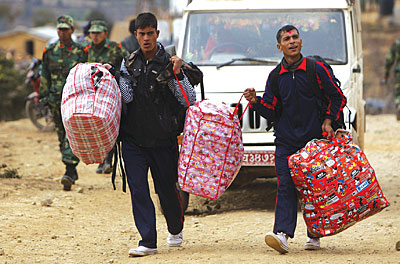 RSS |
Addressing a mass gathering on Jana Andolan Day last year, Maoist Chairman Pushpa Kamal Dahal labelled the opponents of PLA integration 'murderers and criminals'. This year, he said the resignation of the current government would solve all the country's problems. He also made it clear that his party does not have hard feelings against the Nepal Army (NA), and that the two could work together in the national interest.
This does not corroborate with what Dahal said to his cadres in Shaktikhor cantonment in Chitwan last year, according to which 10,000 PLA fighters would be integrated into the NA. This, he surmised, would be enough to ultimately control the institution. "The time has come when the country will be in your hands," he told his cadres, "Why should we worry about your future when we will be running the government?"
The integration process did not gain momentum even when the Maoists were in government, which was a failure on their part, despite their blaming the non-cooperation of the other political parties. The Maoists were not ready to release UNMIN-verified child soldiers and those recruited after verification for political and economic reasons. They finally agreed to discharge 4,008 disqualified PLAs to improve the party's standing in the international community, but this was a decision taken under pressure from the UN and donor agencies. Only 2,394 PLA soldiers were discharged formally, while 1,614 fighters were not in the cantonments during the discharge process. There is no record of them.
There are 19,602 UNMIN-verified PLA fighters in the cantonments, on whom the state has spent Rs 60 billion in three years. The peace process is stuck due to blame games. Technical and high level committees have failed to decide on the issue. The High Level Political Mechanism has been passive and proposed integration schemes have been ineffective. Prime Minister Madhav Kumar Nepal believes it is the Maoists alone who benefit from keeping PLA soldiers in the cantonments.
Although the integration, management and rehabilitation of the PLA is an integral part of the peace process, it is not undisputed. The peace process will be disrupted until there are two armies. The integration and rehabilitation of PLA soldiers are very sensitive issues and require a consensus for resolution. But the leaders of the political parties do not have a specific plan to achieve this.
It has come to light that Dahal and Koirala had agreed to integrate 3,000 to 5,000 PLA soldiers into the NA during the signing of the CPA. But since the demise of Koirala, the Maoists have been saying that their demand was for 12,000 to 14,000 PLA soldiers to be integrated into the army. In the Special Committee, PM Nepal has proposed integrating 5,000 PLA soldiers. But these discussions have only focused on numbers, rather than how and where in the security forces they will be integrated, and what designations they will receive.
The Maoist-led government had proposed a system to rank PLA fighters in the NA. The PLA chief, for instance, would be equivalent to the chief of general staff and a deputy commander would be a general. But there has not been any agreement on the matter with integration numbers still in limbo. Maoist objections to the chain of command and integration procedure proposed by the technical committee attest to this.
The latest Maoist demands include the possibility of integrating all 19,602 PLA soldiers. Those opting for rehabilitation or a political career, according to the Maoists, should receive Rs 2 million or 5 to 10 bighas of land. Alternatives include integration and rehabilitation, setting up a separate Maoist regiment, or creating a new security force comprising PLA fighters, army and police.
At first glance the alternatives don't seem unreasonable. But how logical is it to increase the number of security institutions to address integration? Qualified PLA fighters should be integrated not on the basis of claims and counter claims but on the basis of the CPA and the Agreement on Weapons and PLA Monitoring 2007.
It should be noted here that in the agreement signed by Krishna Bahadur Mahara of the Maoists, nowhere is it mentioned that integration is mandatory. But the fact remains: we cannot avoid the issue of integration on these grounds. It is not just a Maoist but a national concern that will determine the future stability of the country. Those who are totally against integration are as wrong as the Maoists who attempt to put a price tag on their fighers. It should be a matter of shame for revolutionary leaders to confine their fighters to cantonments and then bargain for their release, at a price.
READ ALSO:
Blustering reality - FROM ISSUE #499 (23 APRIL 2010 - 29 APRIL 2010)
Gandhians without guns- FROM ISSUE #499 (23 APRIL 2010 - 29 APRIL 2010)
Constitution 2010, Nepali Times coverage of issues related to writing the new constitution


